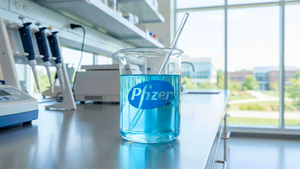
Global pharmaceutical company Pfizer (NYSE: PFE) met Wall Streets revenue expectations in Q3 CY2025, but sales fell by 5.9% year on year to $16.65 billion. On the other hand, the company’s full-year revenue guidance of $62.5 billion at the midpoint came in 0.5% below analysts’ estimates. Its non-GAAP profit of $0.87 per share was 37% above analysts’ consensus estimates.
Is now the time to buy PFE? Find out in our full research report (it’s free for active Edge members).
Pfizer (PFE) Q3 CY2025 Highlights:
- Revenue: $16.65 billion vs analyst estimates of $16.61 billion (5.9% year-on-year decline, in line)
- Adjusted EPS: $0.87 vs analyst estimates of $0.64 (37% beat)
- Adjusted EBITDA: $7.19 billion vs analyst estimates of $6.06 billion (43.2% margin, 18.7% beat)
- The company reconfirmed its revenue guidance for the full year of $62.5 billion at the midpoint
- Management raised its full-year Adjusted EPS guidance to $3.08 at the midpoint, a 2.5% increase
- Operating Margin: 33.2%, in line with the same quarter last year
- Organic Revenue fell 7% year on year vs analyst estimates of 3.2% declines (378.8 basis point miss)
- Market Capitalization: $138.2 billion
StockStory’s Take
Pfizer’s third quarter results reflected ongoing challenges in its COVID-19 franchise, but management pointed to solid growth in non-COVID products and disciplined cost management as key drivers of performance. CEO Albert Bourla emphasized the company’s ability to deliver adjusted earnings above expectations, noting, “Our business is performing well, and we are raising the range of our adjusted diluted EPS guidance for full year 2025.” The quarter saw operational declines in legacy COVID-19 products, but new launches and established brands like Vyndaqel and Nurtec offset some of the softness, supported by ongoing productivity improvements and a focus on high-priority therapeutic areas.
Looking ahead, Pfizer’s updated guidance is shaped by anticipated contributions from its late-stage pipeline, continued cost improvement initiatives, and the pending Metsera acquisition. Management highlighted upcoming clinical trial data and the potential for expanded indications in key therapeutic areas, with CFO David Denton stating, “We plan to continue to invest behind these two product groups to drive future performance and help enable the company to largely offset our loss of exclusivities over the next several years.” The company is also preparing for increased investment in manufacturing and research, while maintaining a cautious stance on COVID-19 product demand.
Key Insights from Management’s Remarks
Management identified several business updates impacting Q3 performance, including new product uptake, portfolio shifts, and external regulatory developments.
- Non-COVID portfolio expansion: Pfizer saw solid operational growth in non-COVID products, especially from brands like Eliquis, the Vyndaqel family, and Nurtec, helping to balance declines in COVID-19 products.
- COVID-19 franchise decline: The company’s COVID-19 portfolio, notably Paxlovid and Comirnaty, experienced lower demand due to reduced disease incidence and a lack of government stockpiling, which weighed on total revenues.
- Manufacturing optimization progress: Continued cost reduction efforts in manufacturing contributed to strong gross margin performance, with management reiterating its goal of $1.5 billion in savings from its optimization program by 2027.
- Business development activity: The proposed acquisition of Metsera and the closing of the 3SBio licensing agreement were highlighted as moves to strengthen Pfizer’s pipeline, particularly in obesity and oncology, despite anticipated near-term dilution to earnings.
- U.S. government agreement impact: A new agreement provided clarity on prescription drug pricing and included a three-year grace period from certain tariffs, allowing Pfizer to focus on U.S. manufacturing investments and strategic priorities.
Drivers of Future Performance
Pfizer’s outlook is driven by new product launches, late-stage R&D milestones, and cost efficiency initiatives, with ongoing external uncertainties.
- Late-stage pipeline readouts: Management expects upcoming clinical trial results in oncology and vaccines to play a significant role, including new data on Padcev, Braftovi/Mektovi, and next-generation pneumococcal vaccines that could expand addressable patient populations and support future growth.
- Cost management and margin focus: The company is targeting additional operational efficiencies through ongoing cost realignment and manufacturing optimization programs, aiming for $7.7 billion in savings by the end of 2027 and reinvesting a portion into priority R&D areas.
- Business development integration: Integration of Metsera and 3SBio assets is expected to add to Pfizer’s growth profile, especially in obesity and cancer, though management acknowledged short-term dilution to earnings and highlighted the need to offset loss of exclusivity for existing products.
Catalysts in Upcoming Quarters
In the coming quarters, our analysts will focus on (1) the pace of late-stage clinical trial readouts, especially in oncology and vaccines, (2) integration progress and early commercial performance of recently acquired Metsera and 3SBio assets, and (3) execution of cost management initiatives and their impact on margins. Progress on regulatory approvals and clarity on U.S. drug pricing policy will also be critical signposts for Pfizer’s long-term outlook.
Pfizer currently trades at $24.34, down from $24.69 just before the earnings. In the wake of this quarter, is it a buy or sell? The answer lies in our full research report (it’s free for active Edge members).
Our Favorite Stocks Right Now
Fresh US-China trade tensions just tanked stocks—but strong bank earnings are fueling a sharp rebound. Don’t miss the bounce.
Don’t let fear keep you from great opportunities and take a look at Top 5 Growth Stocks for this month. This is a curated list of our High Quality stocks that have generated a market-beating return of 183% over the last five years (as of March 31st 2025).
Stocks that made our list in 2020 include now familiar names such as Nvidia (+1,545% between March 2020 and March 2025) as well as under-the-radar businesses like the once-micro-cap company Kadant (+351% five-year return). Find your next big winner with StockStory today.
StockStory is growing and hiring equity analyst and marketing roles. Are you a 0 to 1 builder passionate about the markets and AI? See the open roles here.







